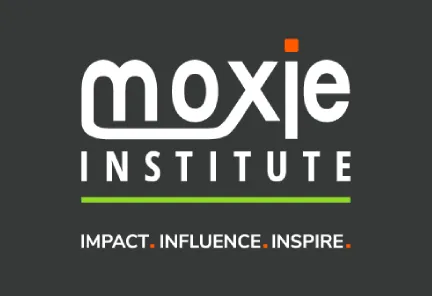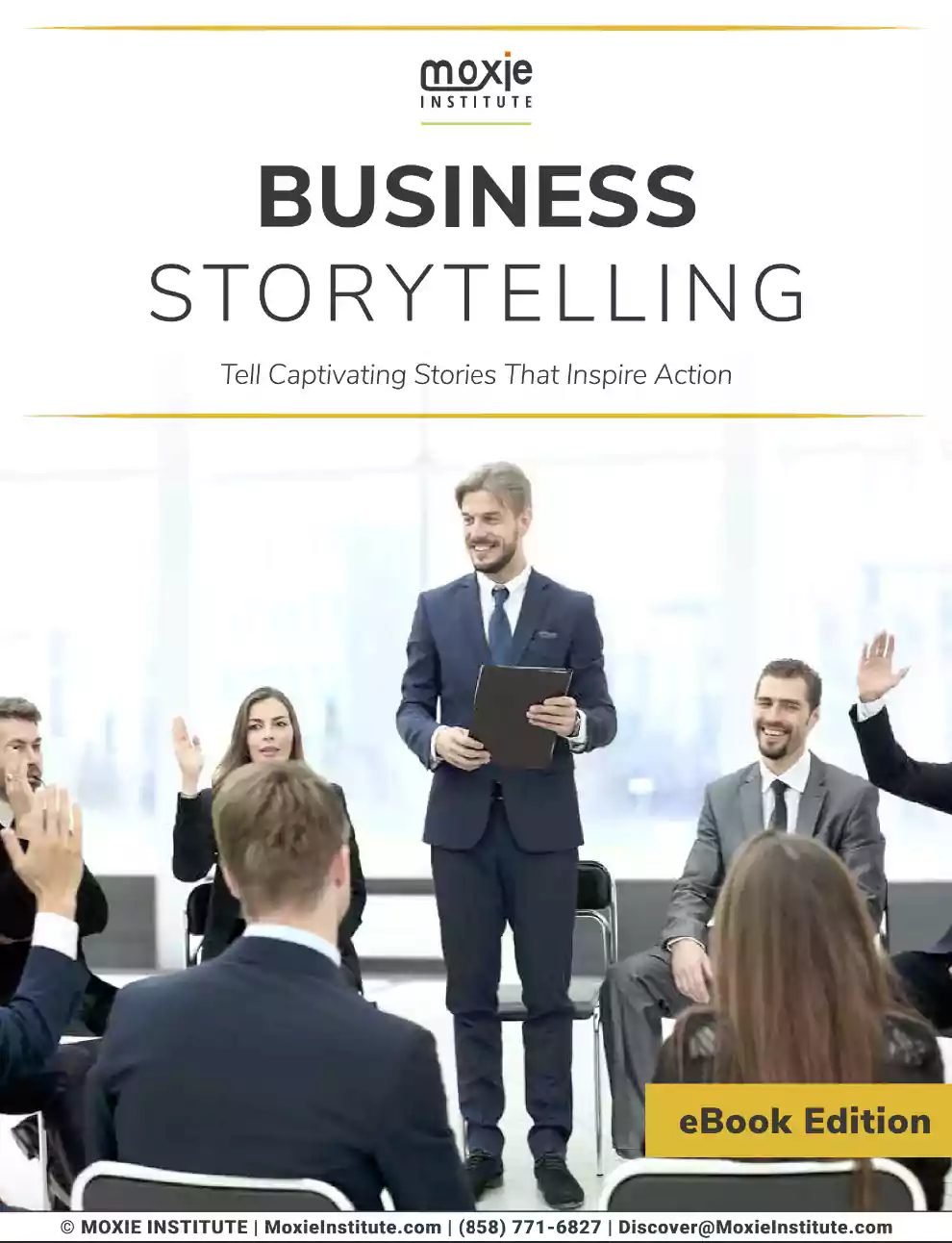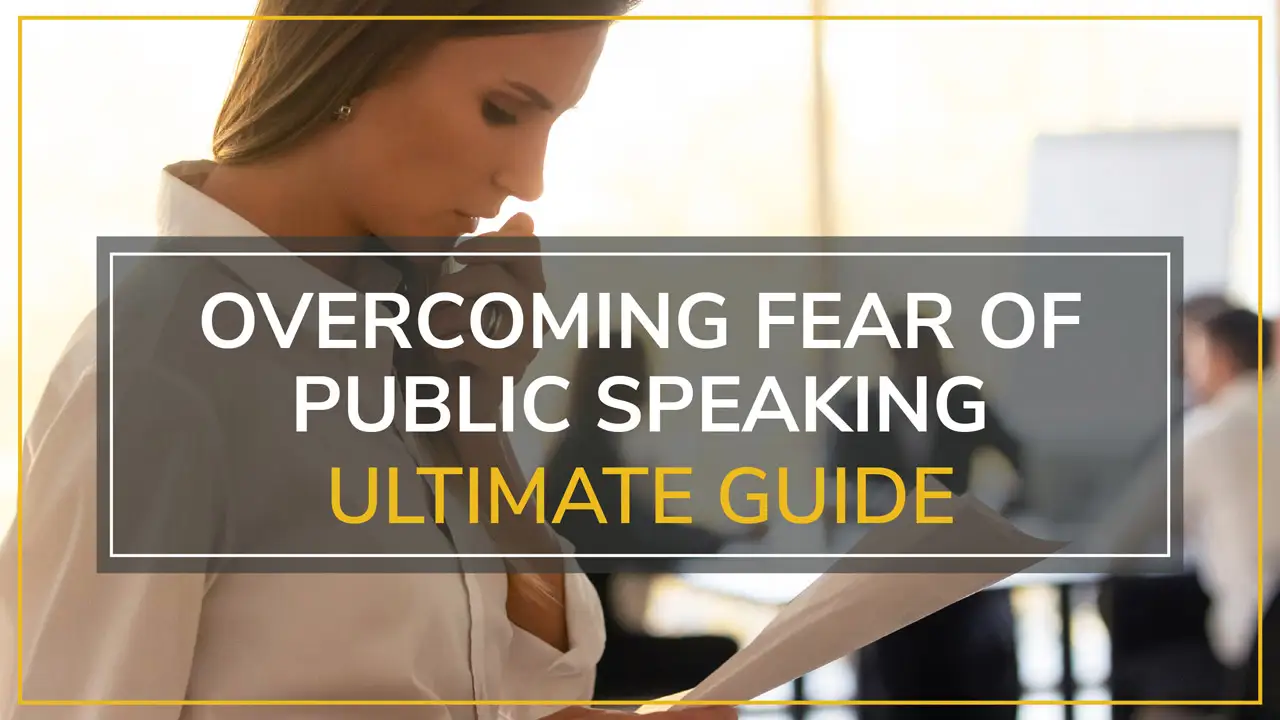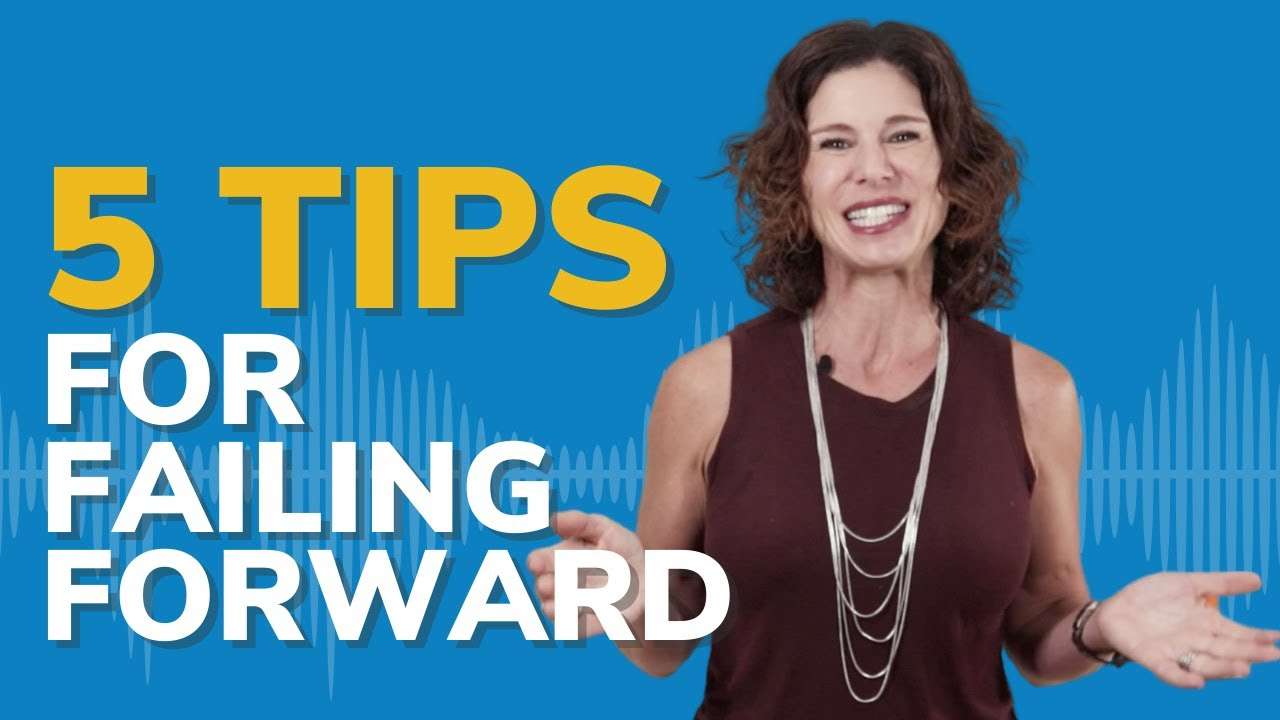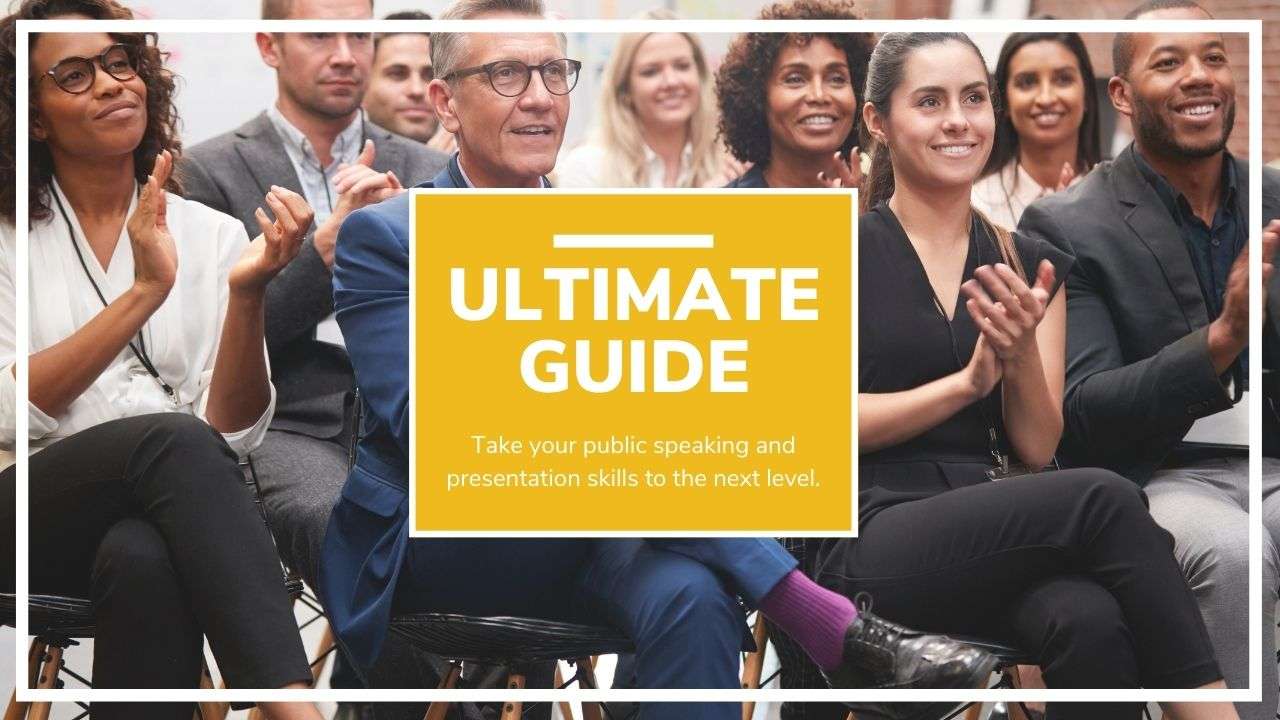Introduction: The Power of Effective Public Speaking
Have you ever watched a speaker captivate an audience with such ease you couldn’t help but wish you were that good? That kind of speaking isn’t magic or a special gift you’re born with—it’s a learnable skill that can take your career, your influence and your impact to the next level.
Learning how to get better at public speaking is listed as one of the most important professional skills in every field of work. The ability to communicate effectively is number one on many employers’ wish lists, with 73.4% valuing good verbal skills above all else, according to figures from the National Association of Colleges and Employers. But speaking with confidence is a hurdle that most professionals struggle to overcome.
At Moxie Institute, we’ve trained thousands of corporate executives, managers, and professionals to master their speaking skills with our evidence-based methodology. We’ve seen firsthand the cascading effects of mastering public speaking tips through a person’s career — early on, through the ranks, in interviews, at funding growth stages, when presenting to teams through change.
Here in this ultimate guide, we will cover the science-based methods, principles of performance psychology, and strategies that we use to teach our Fortune 500 clients how to become a better speaker. Whether that be preparing your first pitch, or preparing to present to clients, this advice will help provide you with more confidence, clarity and impact in your delivery.
Why Most People Struggle with Public Speaking
In order to discover how to become a better speaker, it is important to address why public speaking is so problematic for so many of us. The problems go beyond mere jitters — they stem from both neurological responses and widespread misconceptions about what makes a good speaker.
The Neuroscience Behind Speaking Anxiety
The number stands at approximately 77% of people who have a fear of public speaking, according to the National Institute of Mental Health. And this fear is not purely a psychological response — it is biological. Your brain can jump to the same fight-or-flight instinct when offered the chance to speak as when confronted with physical threats.
Here’s what is going on physiologically when speaking anxiety hits:
- Your amygdala—the part of your brain that serves as a security threat system—turns on because it’s registering social evaluation = danger.
- Your sympathetic nervous system douses your body with stress hormones such as cortisol and adrenaline
- Your prefrontal cortex (in charge of executive function) goes quiet, and it becomes more difficult for you to think clearly.
- Your working memory drains, you forget how you were planning to deliver your content.
We’ve found in our executive coaching work that simply knowing about this neurobiological process is the first step in managing it. As Harvard Business School psychologist Dr. Amy Cuddy’s research has demonstrated, just knowing and reinterpreting your body’s response to stress can dramatically decrease its adverse effects on your performance.
Common Misconceptions About Great Speakers
The reason that most people find it so difficult to develop into better speakers is that they share some fundamental misunderstandings about why someone is considered a good speaker:
Myth 1: Good speakers are naturally good speakers. Truth: Studies on the subject of performance psychology uniformly demonstrate that excellent public speaking is the result of repeated practice, not innate ability. In our work analyzing thousands of working professionals, we have seen speaking skills (or lack thereof) dramatically improve through structured training — no matter where you start.
Myth 2: You have to get rid of all jitters. The truth: Even the most accomplished speakers become anxious before presentations. The distinction is in how they funnel it. According to a study in the Journal of Experimental Psychology, merely applying the label “excited,” rather than “anxious,” improved performance by almost 30 percent.
Myth 3: The best way to deliver a perfect speech is to memorize it. Reality: When you memorize verbatim, you often sound stiff and scripted. The better strategy our executive speech coaches teach: Know what you need to say by heart, then practice extemporaneously in a way that keeps you sounding real.
Myth 4: The audience wants you to fail. Reality: Audiences are typically rooting for speakers to do well. Realizing this basic truth enables speakers to relate to listeners more collaboratively rather than combatively.
The Foundational Elements of Powerful Speaking
Having trained speakers in over 100 industries, we have learned that the three pillars of speaking excellence include authenticity, structure, and delivery. Dominate these and you’ll dramatically enhance your effectiveness regardless of the speaking situation.
Authenticity: The Core of Compelling Communication
Being genuine is where the bond between speaker and listener is formed, and that is what provides the staying power to a message. Listeners know when speakers are trying to be somebody they’re not; we can sense the pivot.
In our presentation coaching sessions, we employ the following approaches to enable speakers to find their authentic voice:
- Values Alignment: What are the things that are important to you and you care about and make sure you’re walking your talk.
- Integration of Personal Narrative: Integrate personal stories that shed light on your message.
- Conviction Cultivation: Share only ideas you truly believe in or care about.
- Conversational Language: Speak using your natural language, not formal ‘presentation speak.’
We coached one CFO who had trouble with executive presentations until we worked with her on finding her authentic voice. Rather than try and mold herself into the aggressively financial presentation style she thought she should be using, she simply delivered it in her naturally, co-operative manner, including stories of success of team achievement to go along with the numbers. The result? Board members said it led to a 40 percent increase in message retention and more confidence in her leadership.
Structure: The Backbone of Memorable Speeches
Without clear organization, even the most charismatic speaker falls flat. Your listeners must have a rational path through your material to be able to follow your message.
Cognitive psychology research reveals that information presented systematically is remembered up to 40 per cent more often than if it were to be presented in disjointed fashion. At Moxie Institute we teach several tried-and-true structures including:
- The Problem-Solution-Benefit Framework: This simple persuasion technique uses 3 stages. Start with a problem your audience has…next present your solution…and finish with the benefits to them…your results or your product.
- The What-Why-How Approach: Tell people what you’re suggesting and why it matters; describe how you’re proposing the change.
- The 3-Act Structure: Establish the situation, complicate/conflict, and resolve in a concrete ending.
- The Mountain Technique: Start at the bottom with tension building as you make your way to the peak and then traverse down through a practical.
The structure you select should reflect the message you have and what your audience will need. For a technical audience, flatter structures may work best; narrative structures might be better for broader audiences. When working with a good public speaking coach, they can help you determine which structure is ideal for your specific speaking situation.
Delivery: How Your Message Resonates
What you say is important, but how it reaches the audience is paramount. There are many components to good delivery:
- Vocal dynamics: Rate, pitch, volume and emphasis.
- Physical communication: Posture, movement, gestures, and facial expressions.
- Audience connect: Eye contact, engagement tips, and being alive to respond.
- Environmental education: Space management and fitting into the environment.
From our experience working with TED speakers and Fortune 500 executives, we’ve learned that increased effectiveness in delivery is the factor that most immediately changes an audience’s perception. One tool we teach is “contrastive emphasis”—intentionally changing how delivery elements are timed and placed to give extra attention to focus points—which according to research can boost memory-recall of messages by as much as 65%.
Mastering Your Mindset: Performance Psychology for Speakers
When it comes to speakers, the difference between the good and the great is mindset. With the application of a few performance psychology tools that have been working for elite athletes and performers – you can revolutionize your experience of speaking and your effectiveness at it too.
Reframing Nervousness as Excitement
Excitement and performance anxiety have essentially the same physiological traits — an elevated heart rate, rapid breathing and exaggerated alertness. The only distinction is how you interpret those feelings.
Harvard psychologist Alison Wood Brooks has some research suggesting that just saying “I am excited” (as opposed to “I am calm”) before delivering a presentation helped performance substantially better than if you told yourself to calm down. It’s part of our speaker coaching curriculum now, this “anxiety reappraisal.”
Here’s a practice we use with our executive clients:
Anxiety Reframing Exercise
- Realize the feeling with your next talk of what it feels like to be anxious.
- Instead of fusing it to “anxiety,” intentionally name it as “readiness” or “activation.”
- Repeat: “I’m looking forward to the chance to tell you about my ideas.”
- Champion what you gain and not lose.
- Ride that energy for your presentation instead of trying to keep it at bay.
In our executive program doing this type of reframing, clients report, on average, a 32% reduction in the amount of anxiety they feel being in front of groups along with significantly improved audience evaluations.
Visualization Techniques That Actually Work
As it turns out, Olympic athletes have been practicing visualization for decades, and neuroscience confirms that speakers should follow suit. Functional MRI studies have shown that imagining a movement can activate much of the same neural circuitry as actually performing it.
The most effective visualization techniques for speakers include:
- The Visualization of Success: What That Should Look Like Including the Reaction of the Audience.
- Process Visualization: Visualizing the exact process of your presentation in your mind.
- Visualizing The Obstacle: Imagining the problem solution and how you’d later navigate around it.
- Engaging Your Senses: Utilizing all of your senses in visualization.
One senior leader that we coached used an extensive imagery process before a high-stakes investor presentation. In addition to imagining her delivery, she was using the space’s room and imagining the questions she might be asked, and her calm responses. That pitch won her a total of $18 million in funding, something she partly credited to her mental preparation.
Building Your Public Speaking Toolkit
Learning how to be a great public speaker is about learning how to gain tools that you’ll use whenever you speak. Let’s dive into the very most important parts of, as we’ve learned from training thousands of professional speakers.
Storytelling Strategies That Captivate Audiences
The cognitive psychologist Jerome Bruner finds that stories are 22 times more memorable than just plain facts. This is why telling a story is crucial to great public speaking.
In our business storytelling workshop we teach these time-tested narrative templates:
- The Hero’s Journey: Framed as ordeal, struggle, and awakening.
- The Contrast Method: The contrast method is based on comparing “what is” with “what could be”.
- The Connect Story: Discovery of a common thread through shared experiences.
- The Curiosity Gap: Generating and eliminating knowledge gaps to maintain engagement.
Remember these principles when using stories:
- Make your story about the audience being the hero or the beneficiary.
- Add details: sensory details that will make mental images for the reader.
- Make the story relevant to your central message.
- Time your response to keep interest without getting off track.
Expert Insight: One strategy we teach here at Moxie Institute is “emotional anchoring,” where you anchor your key takeaways to emotional moments within your stories. This method has been proven to improve information retention by as much as 45% over delivering information without emotional context.
Body Language That Reinforces Your Message
Your body language can scream louder than words. Studies from UCLA have shown that as much as 55% of what you communicate comes from your body language and visual cues such as posture, gestures and facial expressions.
Through our coaching experience, these are the most critical body language elements to focus on:
- At-stake stance: Equal weight on both legs indicating self-assuredness.
- Figuring hand gestures: Gestures of the hand that model and mark significant points.
- Facial expressions: Video animations that are enthusiastic and genuine.
- Strategic action: The purposeful use of space to amplify your message.
Common Body Language Mistakes to Keep an Eye On
Mistake | Impact | Correction |
Crossed arms | Signals defensiveness | Use open gestures that welcome engagement |
Random pacing | Creates distraction | Move with purpose to emphasize transitions |
Lack of eye contact | Diminishes trust | Practice the “lighthouse technique” of scanning the room |
Fidgeting | Displays nervousness | Channel energy into deliberate, expressive movements |
In the presentation skills workshops that we deliver, we videotape speakers so they can see and then change their nonverbal habits. Small changes can go a long way in terms of how audiences will perceive you!
Vocal Variety and Presence
A monotonous presentation could spoil the best script. Your voice is a powerful instrument that can emphasize points, create emotional resonance, and keep the audience engaged.
Vocal things to grow and flourish:
- Pace: Changing the speed of your speech to highlight the point/quicken engagement.
- Tone: Up and down pitch variation to grab attention.
- Volume: Strategic amplification and quieting to focus attention.
- Silences: Utilizing silence to effect and for understanding.
Mastery of these vocal ingredients can be far more rapid when certain elements are practiced under the eye of a skilled speech coach, leading you to find your own authentic voice and style.
Try It Yourself: The Vocal Impact Workout
Take a mundane sentence like “This project will revolutionize the way we do customer service.” Practice saying it several different ways:
- As a question
- With excitement
- With serious conviction
- Stressing Different Words Each Time
- With a pause before its key moments
Record yourself and notice how it is different. Which one feels the most profound? Distinctly most natural to your speaking style?
In our media training courses, we’ve learned that executives who learn to use vocal variety experience as much as a 60% increase in audience engagement, along with significantly greater message recall rates.
Preparation Methods That Transform Your Results

The most powerful presentations are built on a foundation of thorough, strategic preparation. Based on our work with thousands of speakers, we have developed preparation methodologies that have consistently produced exceptional results.
The Rehearsal Revolution: Beyond Simple Practice
Most people practice incorrectly, which cements problems rather than solving them. Effective rehearsal combines principles from performance psychology and adult learning theory, making the improvement lasting.
The Moxie Rehearsal Method includes these key elements:
- Chunking: Breaking your presentation into manageable sections.
- Progressive Loading: Starting with content mastery before adding delivery elements.
- Interval Practice: Short, focused sessions with breaks between.
- Deliberate Difficulty: Intentionally creating challenges during practice.
- Feedback Integration: Systematically incorporating input between iterations.
Structured practice and its result, supported by research in cognitive psychology, results in stronger neural pathways than when using traditional methods of preparation, which leads to a more consistent performance in a high-pressure environment.
Pro Tip: We teach the “3-2-1 Countdown Method” to our executive clients for high-stakes presentations, which means three full run-throughs two days before, two the day before, and one final review on the day. It maximizes readiness and eliminates the risk of burnout, which occurs through last-minute practice.
Technology Tools for Speech Improvement
Modern technology offers robust resources to enhance your speaking skills:
- Video analysis apps: Record and review your practice sessions with tools that highlight speaking patterns.
- Real-time feedback platforms: Making use of AI-powered coaching instruments that will provide suggestions on pace, clarity, and filler words.
- Virtual reality practice environments: Simulate audience conditions to build comfort and adaptability.
- Speech analytics software: Identify patterns in your verbal and nonverbal communication for targeted improvement.
Technology can improve the rate of improvement. Moxie’s experience shows that the best results can be achieved when the above methods are combined with individual coaching, as the human element—context, nuances, and individual strengths—is crucial for the highest level of speaking performance.
Handling Challenging Speaking Situations

Difficult circumstances happen to all of us, even the experienced. Creating tactics for these challenges will give you the confidence you need to deal with any speaking engagement. All-rounded public speaking training should include training on how to prepare for such difficult situations.
Managing Difficult Questions with Confidence
Q&A is generally more stress inducing than talking is. Our media and executive communication training teaches a methodical way to address even the toughest questions:
The PREP Framework for Question Management:
- Pause: Reflect before you respond.
- Rephrase: Restate the question and make sure you understand it!
- Explain: Briefly make it clear in your own words.
- Pivot: Bridge to a relatable message if necessary.
We teach them to employ, for very tough questions, the “acknowledge and bridge” technique:
- Accept the question as valid.
- Briefly address what you can.
- Bridge: Related information you shouldn’t miss. This is data you can talk about with confidence.
Common Pitfalls in Question Handling
Pitfall | Better Approach |
Becoming defensive | Maintain composure and respond with evidence |
Overcomplicating answers | Provide concise, clear responses |
Pretending to know everything | Be comfortable saying “I’ll find out” when appropriate |
Allowing one questioner to dominate | Thank them and invite questions from others |
Recovery Techniques When Things Go Wrong
Even the most organized speakers have their struggles from time to time—technical issues, brain lapses, interruptions by the audience. It’s not that great speakers never run into trouble, but how they navigate out of it.
In our crisis communication training, here is what we teach for recovery techniques:
- Pause and Reset: Taking a moment by design to regroup.
- Strategic Transparency: A Warrant for Issue Salience without Issue Stressing.
- Prepared Pivots: Being prepared for the common problems with alternatives.
- Deployment of humor: The tactical utilization of appropriate humor to lessen hostility.
We had one CEO we’d coached who had a total technology failure during an IPO roadshow presentation. As opposed to freaking out, he went with the flow and showed he was adaptable, and it worked — he refused to let it get to him and switched to a discussion format on the fly which honestly got investors more engaged than his initial slide-based approach.
Your 30-Day Public Speaking Transformation Plan
The following 30-day challenge is a product of our experience with rapid-improvement coaching programs that guide our clients through the process of mastering speaking skills, one day at a time. Each week constructs on former weeks to promote a well-rounded development.
Week 1: Foundation Building
Days 1-2: Evaluation and Goal-Setting
- Record a short lecture from yourself.
- Identify 3 strengths and 3 areas of weakness.
- Define your goals for improvement in your speaking performances.
Days 3-5: Content Development
- Choose a presentation topic.
- Use one of the frameworks to build yourself clear structure.
- Develop supporting ideas and reasons.
Days 6-7: The Building Blocks of Delivery
- Exercise posture and breathing methods.
- Start working on your most frequent fillers.
- Start with simple exercises in vocal variety.
Week 2: Skill Building
Days 8-10: Developing Your Storytelling Voice
- Pick 2-3 personal anecdotes that are applicable to your usual presentations.
- Frame these stories with a structure.
- Practice telling them “emotionally.”
Days 11-12: Visual Enhancement
- Work on the inclusion of purposeful gesture.
- Exercise your facial expression and animation.
- Be more comfortable with tactical movement.
Days 13-14: Vocal Mastery
- Work on speed, tone and volume diversity.
- Practice strategic use of pauses.
- Record and process your vocal tracks.
To speed up the process, consider attending a structured public speaking workshop to make sure you not only learn from real professionals but also get some professional feedback in this crucial learning phase of yours.
Week 3: Integrated Practice
Days 15-17: Chunked Rehearsal
- Prepare your speech in pieces.
- Keep transitions between main points short and simple.
- Incorporate feedback between iterations.
Days 18-19: Audience Engagement
- Prepare questions to engage the audience.
- Practice being versatile in front of an audience.
- Make sure your openers and closers are tight.
Days 20-21: Stress Testing
- Practice under simulated pressure.
- Create moments of intentional distraction in rehearsal.
- Train for recovery from typical issues.
Week 4: Refinement and Performance
Days 22-24: Full Integration
- Run complete run-throughs with all elements.
- Record, analyze and tweak if necessary.
- Vary time limits with practice.
Days 25-27: Feedback and Adaptation
- Share with a select audience of people you trust.
- Incorporate their feedback.
- Fine tune the last pieces in content and delivery.
Days 28-30: Final Preparation and Execution
- Mental practice and imagery.
- Body and voice preparation rituals.
- Confident presentation with real presence.
Quick Takeaways: Your 30-Day Plan
- Focus on one improvement at a time.
- Practice consistently in short, focused sessions.
- Record yourself regularly to track progress.
- Seek feedback from trusted sources.
- Step up the difficulty level as you progress.
Frequently Asked Questions
What’s the quickest way to improve my public speaking skills?
The best strategy incorporates structure, feedback and deliberate practice. Begin by recording your presentations now, so you have a baseline. Find 1-2 specific things to improve at a time rather than overwhelming your brain with trying to alter everything at once. Get a speech coach or friend that you trust for objective feedback. Practice in short, focused bursts (15-20 minutes), not marathon rehearsals. There is evidence in skill acquisition research that this spaced practice method increases learning 300% more than cramming.
To make faster progress, try to get those foundations of structure and content in place, as it’s these aspects that most affect audience understanding. Once you have your organization down solid, work on grooming delivery tools such as vocal variety and movement.
How can I overcome extreme nervousness or speaking anxiety?
Almost everyone is anxious when it comes to public speaking, but when approached in the right way it can be managed well. Start with cognitive reframing: accepting that symptoms of nervousness (racing heart and butterflies) are exactly the same as excitement. Re-framing these sensations and naming them something like “performance energy” rather than “anxiety” can immediately diminish their power over you.
For chronic anxiety, consider these evidence-based strategies:
- Master preparation: Deep expertise in what you’re presenting brings confidence.
- Exposure therapy: Slowly raise the bar on speaking in safe places.
- Visualization: Visualize successful speaking experiences in your mind.
- Breathing techniques: Do diaphragmatic breathing to stimulate the parasympathetic nervous system.
- Progressive desensitization: Begin with speaking exposures that are not too overwhelming and gradually work upward.
In our practice of executive coaching, we have discovered that these hybrid methods dramatically reduce subjective ratings of anxiety by 60-70% within 4-6 weeks.
Should I memorize my speech word-for-word?
Total memorization is seldom the most appropriate approach for the typical business presentation. Studies in communication psychology indicate that when you memorize your words, you’re more likely to deliver your speaking lines stiffly and unnaturally and be nervous because of concern over forgetting a particular line.
A better alternative would be:
- Memorizing your “open” and “close” verbatim.
- Enough preparation to know your main points and the order of those points well enough.
- Doing the material so much that you become the flow.
- Building a solid framework in your mind.
- With little prompts or pictorial anchors if necessary.
This “structured flexibility” approach allows you to be responsive to the audience but still land all your key points. We’ve estimated that it decreases cognitive burden of delivery by as much as 40% over rote memorization. For really big speeches, executives sometimes use professional speech writing services to write a number of key messages and then provide the exec the flexibility in delivering them.
How do I keep the audience engaged during longer presentations?
Audience focus typically naturally ebbs at around 10 minutes, according to cognitive research. Fight this waning attention with the following engagement techniques:
- Pattern interrupts: Switch up the way in which you present every 8-10 minutes (talking to questioning, story-telling to data, etc.)
- Audience involvement: Make use of polling, paired discussions or simply ask the audience.
- Strategic movement: Engage physical arrangements of people/bodies to communicate shifting locations.
- Multimedia variation: Vary between visual aspects.
- Narrative tension: Open and close curiosity gaps from the opening moments of your story to the conclusion of your story.
One technique we teach at Moxie Institute is called the “Engagement Arc”—you map out the points in your presentation where you want to engage the audience to pay it off over the timeline of your presentation.
How do I handle technical information without losing my audience?
We risk losing interest if we are bombarded with highly complex, technical information to process. In our data storytelling course, we share these proven techniques:
- Simplification without dilution: Retain the compliment of the magic sauce, without maintaining the unnecessary complexity.
- Strategic analogies: Map complex concepts onto everyday experiences.
- Progressive disclosure: Stratification of information, beginning with the most important layers.
- Visual reinforcement: Keep visuals simple, informative rather than spending an hour talking about it.
- Chunking: Divide related information into a series of small units.
Instructional design research proves that these content delivery methods improve retention of technical material by 65% over traditional technical presentations.
What’s the difference between good and great public speakers?
From working with thousands of speakers at all levels of proficiency, we’ve pinpointed the difference that makes the difference when it comes to good vs. truly great communicators:
- Audience-centricity: The best speakers care totally about their audience rather than their own performance.
- Adaptability: They can take what they hear and course-correct at the speed of real time.
- Authentic presence: They show up as they are in every presentation.
- Strategic preparation: They still prepare — but strategically.
- Emotional range: They have an ease accessing and expressing the right emotions.
- Recovery skill: They take challenges in their stride.
The bottom line of exceptional speaking isn’t charisma or being blessed with natural ability—it’s the deliberate practice of skill and a deep desire to help the audience by effectively engaging them.
How can I make my virtual presentations more engaging?
The speaking environment is a different one, which means that the speaking habits for a virtual audience and a real one are not transferable. Here’s what we teach in our program to master virtual communication:
- Enhanced energy: Up to 20% more animation than in-person delivery.
- Camera connection: Making genuine eye contact by simply getting the camera angle right.
- Visual simplification: With clean, less detailed visual elements.
- Interaction planning: Adding interactive elements 5-7 minutes apart.
- Technical mastery: How to be proficient in the tools of the virtual trade.
Virtual presentations using such strategies can increase audience retention and participation rates, on average, by 57% over traditional forms of virtual delivery. Many professionals find that using a professional speech writer has allowed them to create more concise, focused virtual presentations that keep their audience engaged in a digital space.
Is professional speech coaching worth the investment?
The importance of speech coaching can be subjective but target goals, and the role of communication makes its value clear. At Carnegie Mellon University, the executives who were professionally trained to communicate saw an average of 700% return on the training through increased leader effectiveness, team morale, and promotions.
Based on our experience, professional speech coaching is most valuable to:
- Leaders with direct consequences of communication for the organizational bottom line.
- Professionals with high-stakes speeches to give in the foreseeable future.
- People for whom perception matters a lot to their success.
The external coach can provide the well-needed view of the objective state of affairs to make sure the leader gets back on track.
TAKE THE FIRST STEP TO MASTER POWERFUL NEW SKILLS
Schedule an easy 30-minute call using our using our calendar. We’re here to help!
